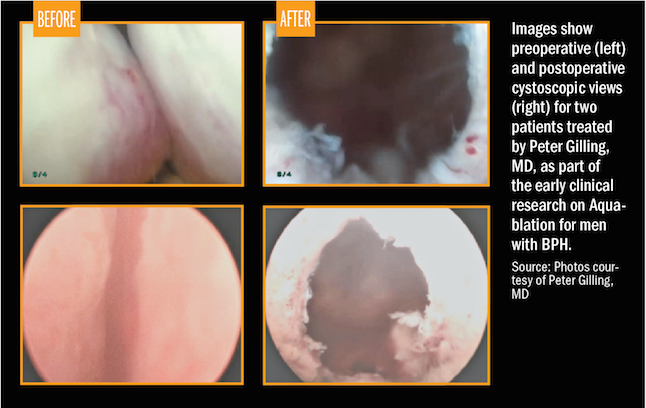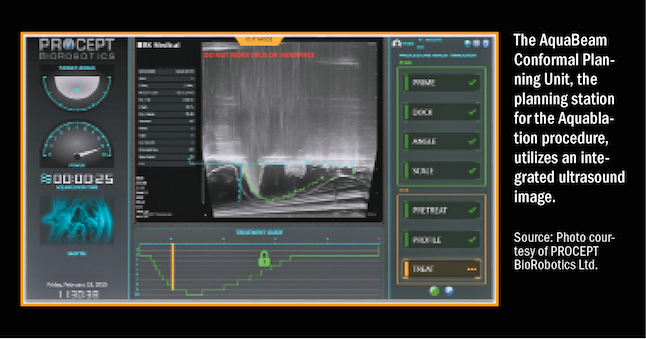Article
BPH modality may offer efficient option
Author(s):
A novel treatment for the targeted removal of prostate tissue may soon be coming to a hospital near you. According to the results of a phase II study presented at the AUA annual meeting in New Orleans, Aquablation, a minimally invasive water ablation therapy, demonstrated efficient and precise resection of prostate tissue in patients with BPH.
New Orleans-A novel treatment for the targeted removal of prostate tissue may soon be coming to a hospital near you. According to the results of a phase II study presented at the AUA annual meeting in New Orleans, Aquablation, a minimally invasive water ablation therapy, demonstrated efficient and precise resection of prostate tissue in patients with BPH.
“Based on what we have seen and experienced, Aquablation is promising, safe, and feasible. This combination of surgical mapping with the high-velocity saline and robotic guidance will considerably shorten ablation time in the operating room,” said lead author Peter Gilling, MD, associate professor of surgery at Grace Prostate Cancer Center, Tauranga, Bay of Plenty, New Zealand.

According to Dr. Gilling, interventional therapy is an option to alleviate symptoms for men who fail medical management of BPH, but current treatments are a trade-off between improvement of patient symptoms and risk of complications.
“Aquablation has the potential to standardize BPH surgery, reduce the level of complexity required to deliver safe and effective therapy, and ultimately improve the quality of life for men suffering from BPH,” he said.
NEXT: System delivers precise, high-velocity saline jet
More on BPH
Study: BPH procedure’s benefits sustained at 3 years
Bipolar vaporization: Do benefits outweigh risks?
BPH technique efficacious even in severe obstruction
The Aquablation system uses the still-investigational AquaBeam (PROCEPT BioRobotics Ltd.) to deliver a precise, high-velocity, saline jet at room temperature, allowing precise control, Dr. Gilling explained. The system has three components: a conformal planning station, which plans the depth and area of tissue to be removed; a transrectal ultrasound display; and a robot arm, which attaches to the endpiece.

The study enrolled 21 patients at two sites in Australia and one site in New Zealand. The authors evaluated the pre-, intra-, and postoperative complication rate, quality of life symptoms, urinary flow rate, and urodynamic obstruction as confirmed by urodynamics. Although Dr. Gilling presented 6-month data, follow-up is planned through 3 years.
100% technical success rate
“The procedure had a 100% technical success rate,” Dr. Gilling reported, “and reduced symptoms demonstrated by a 15.9-point decrease in the mean International Prostate Symptom Score (IPSS) at 6 months.”
Improvement in urine flow was also observed, with a 10.1 mL/sec increase in the peak urinary flow rate (from 8.6 to 18.7 mL/sec).
The mean procedure and resection times were 38 minutes and 5 minutes, respectively. Postoperative dysuria (painful urination) was minimal and adverse events were typically mild and transient. There was no occurrence of urinary incontinence or loss of ejaculatory or erectile function among study patients.
“Most patients had their catheters removed the morning after surgery and were discharged,” Dr. Gilling noted.
NEXT: Could be preferred treatment option in future if price remains low, Dr. Gilling suggests
Although the cost of the device has yet to be determined, Dr. Gilling suggested that Aquablation might one day be a preferred option of treatment if the price remains low.
“Economics will come into the equation,” he said, “and will depend on the actual cost of the device and how much the disposable handpieces cost. This should be weighed against the considerably shortened operating room time that is expected and also the quantifiable and precise nature of planning. I think the administrators do like this element.”
The next step for the technology will be the W.A.T.E.R study (Waterjet Ablation Therapy for Endoscopic Resection of prostate tissue), a prospective, randomized, blinded controlled clinical trial that will begin later this year and, according to Dr. Gilling, will “provide definitive clinical data to evaluate the efficacy of the procedure.”
PROCEPT BioRobotics provided funding for the study. Dr. Gilling is a consultant/adviser and investigator for PROCEPT BioRobotics, and his co-authors are investigators for the company.
More from Urology Times:
Study supports BPH laser’s use in high-risk men
Study uncovers 400% cost difference in BPH treatments
ACA, MACRA: What they mean for you, patients
Subscribe to Urology Times to get monthly news from the leading news source for urologists.
















